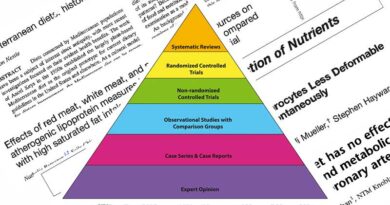Sugar vs Carbohydrate – what’s the difference?
The story for this week was inspired by a tweet by someone with whom I’ve written a couple of academic papers: Dr James DiNicolantonio. James tweeted about his latest paper, published in BMJ Open Heart (Ref 1), but it was the graphic in the tweet that caught my eye. The graphic was a representation of the amount of sugar in a number of different foods, but with the sugar content represented as cubes of sugar.
The bottom left hand corner of the graphic reported the source as “Leo Delauncey/MailOnline”, but the picture had no label to describe exactly what was being illustrated. It made me wonder – is that added sugar, free sugars, or carbohydrate? What’s the difference anyway? This proved to be a really enlightening issue to explore.
We need to start with a quick description of carbohydrates (you will soon start to wonder what’s the difference between sugar and carbohydrates). Then we need to sort out sugar, added sugar, free sugars etc and then we will be able to answer the question: what are the sugar cubes supposed to represent and are they a fair reflection of the actual sugar content of each food shown?
What are carbohydrates?
Carbohydrates can be divided into three categories: monosaccharides; disaccharides and polysaccharides. Saccharide comes from a Greek word meaning sugar. Mono means one; di means two and poly means many, so...
Monosaccharide means one sugar. The three most common monosaccharides are:
- Glucose (found commonly in fruit and grains);
- Fructose (found commonly in fruit);
- Galactose (found commonly in milk).
Disaccharide means two sugars. The three most common disaccharides are:
- Sucrose (one molecule of glucose and one of fructose) – what we know as table sugar;
- Lactose (one molecule of glucose and one of galactose) – what we know as milk sugar;
- Maltose (two molecules of glucose) – less well known as malt sugar.
Polysaccharide means many sugars. Polysaccharides come in digestible and indigestible forms. The digestible forms of polysaccharides are:
- Glycogen. This is the form in which animals (including humans) store energy – in the liver and muscles in the body. Glycogen is made up of thousands of glucose molecules.
- Starch. This is the form in which plants store energy – as in grains, pulses, potatoes and root vegetables. Starch is made up of thousands of glucose molecules.
The indigestible forms of polysaccharides are collectively called fibre. Fibre contains sugars linked by bonds, which cannot be broken down by human enzymes, and are therefore deemed indigestible. There are two forms of fibre:
1) Insoluble fibre (which does not dissolve in water). This includes cellulose, hemicellulose and lignin. Cellulose can be found in whole-wheat flour, bran, and vegetables. Hemicellulose can be found in bran and whole grains. Lignin is a woody fibre found in wheat bran and the seeds of fruits and vegetables;
2) Soluble fibre (which dissolves, or swells, in water). This includes pectins, mucilages, and gums. These substances are not broken down by human enzymes, but instead can be fermented by bacteria in the large intestine. Pectin can be found in apples, strawberries and carrots. (Because it absorbs water and forms a gel, it is often used in jams and jellies). Mucilages and gums are similar in structure. Sources of gums include oats, legumes (beans, peas), guar and barley.
The key fact to remember is that, during digestion, all carbohydrates need to be broken down into monosaccharides (simple sugars) to be absorbed. This means that all digestible carbohydrate either is, or breaks down into, sugar.
Let’s now turn to sugar itself.
The rest of this article is available to site subscribers, who get access to all articles plus a weekly newsletter.
To continue reading, please login below or sign up for a subscription. Thank you.




